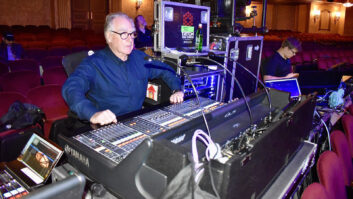NEW YORK—In the late Eighties, pop metal ruled the airwaves. The spandex was tight, the music was loud and the only thing bigger than the hair was the cannon-like drum sound. The period, for better or worse, has been amply captured in the Broadway musical, Rock of Ages. Set on the Sunset Strip, the story follows lovestruck metalheads in 1987, belting out hits by everyone from Poison to Pat Benatar.

The show has a party atmosphere, with a live band on stage, an orchestra in the pit, and plenty of tricky sound issues to avoid while creating a theatrical experience with a rock vibe. As a result, sound designer Peter Hylenski, who was fresh off another hit, Shrek, when he tackled the metal musical, had to approach the show from a different direction.
“Shrek was grounded in traditional musical theatre style,” he said, “while Rock of Ages is more of a rock concert. It’s still a theatrical evening with scenes and dialogue, but the level in the house is much louder than a typical show on Broadway. However, you still need to give the cast that ability to hear what’s going on and themselves so they can sing the show eight times a week. It’s a tricky situation.”
In order to keep the stage volume down—and more importantly, to gain as much control over the mix as possible—the band uses personal monitor systems, hearing mixes created on an input-jammed Yamaha MC7L monitor desk that sports more than 100 snapshots. Aiming to recreate the sound of the times, roaring guitar amps are off-stage in iso boxes, captured by Shure SM57s, while the bass and keyboards are both direct. The drum kit, surrounded by a containment system combining Plexiglas with absorbing panels, also sports mics typical of the era, such as AKG 451s on overheads.
“The name of the game is control and whenever you’re in a theatre setting, you need control over everything,” said Hylenski. “The show is written almost in a film style where you’ve got rock and roll music happening because they’re in a club, but there’s dialogue between characters. Control gives us the ability to place that dialogue over a full-out rock and roll guitar solo and not have to run everything at full volume; we can dictate where the band is, how loud they are and how the mix relates to its level. Of course, the operator only has two hands to mix the whole show, so everything has to be programmed and thought through in order to retain the impact and power so the music sounds big and full, but you can also hear what they’re saying.”
That mix is being handled on an Avid Venue Profile console; although it’s a digital desk, there’s plenty of analog outboard gear at the mix position. “We’ve got some Summit tube gear, a lot of Empirical Labs Distressors, the Eventide H3000, a TC Electronic System 6000, some Tube Tech, Universal Audio stuff, and we’re running Cadac mic pres,” said Hylenski. Plug-ins applied on the show include various Waves compressor emulations, including the C4 multiband compressor: “That helps when they’re belting out those songs with the headset right there; we can change some things with it,” he said. “We even use Avid’s Reel Tape Suite for analog tape emulation; we run it at that final stage across the band mix to get the saturation feel and blends everything together, giving it more of a warm analog feel.”
The Profile feeds into a Meyer Sound LCS system, used to handle all matrixing and panning, while all sound effects are played back from a Wild Tracks hard disk system. A Meyer Galileo unit handles processing and correction for the line arrays, which are Meyer M’elodies supported by 700 HP subs, CQ1 and 2s, and M1Ds.
“The difference is between our theatre loudspeaker system and a rock concert system is pretty large,” said Hylenski. “The distance from the stage to back-of-house isn’t that great, but you still have a wide proscenium [separating your speaker hangs]. Meanwhile, you have a performer who comes out right into the house past the first couple of rows, and you’ve got to get coverage down there, imaging, power and clarity. It becomes a little bit of a challenge.”
While the audience is broken into a multitude of speaker zones, so is the stage. While the band is on personal monitor systems, the cast has the benefit of speakers, from boxes hidden in the scenery to grills cut in the floor. “Wherever you are on stage, you’ve got good coverage,” said Hylenski,” and we’ve got it zoned out so the monitor engineer can feature certain parts of the stage as the cast moves around. If somebody’s down center, he can send more vocal to the down center fills and ease up on the stage volume by taking it out of some of the other monitors further upstage that really aren’t effective.”
All the hard work creating the audio system helped pave the way to a Tony Award nomination in 2009 for Best Musical, as well as Hylenski’s own nomination for Best Sound Design of a Musical. The proof that it hits audiences where it counts, however, can be found nightly as the raucous crowds tend to dance in their seats and belt along with the show. By the time the revelers leave the theatrical experience, there’s no doubt that Hylenski’s sound design on Rock of Ages has rocked the house.
Rock of Ages
www.rockofagesmusical.com
Meyer Sound
www.meyersound.com
Avid
www.avid.com
Waves
www.waves.com







